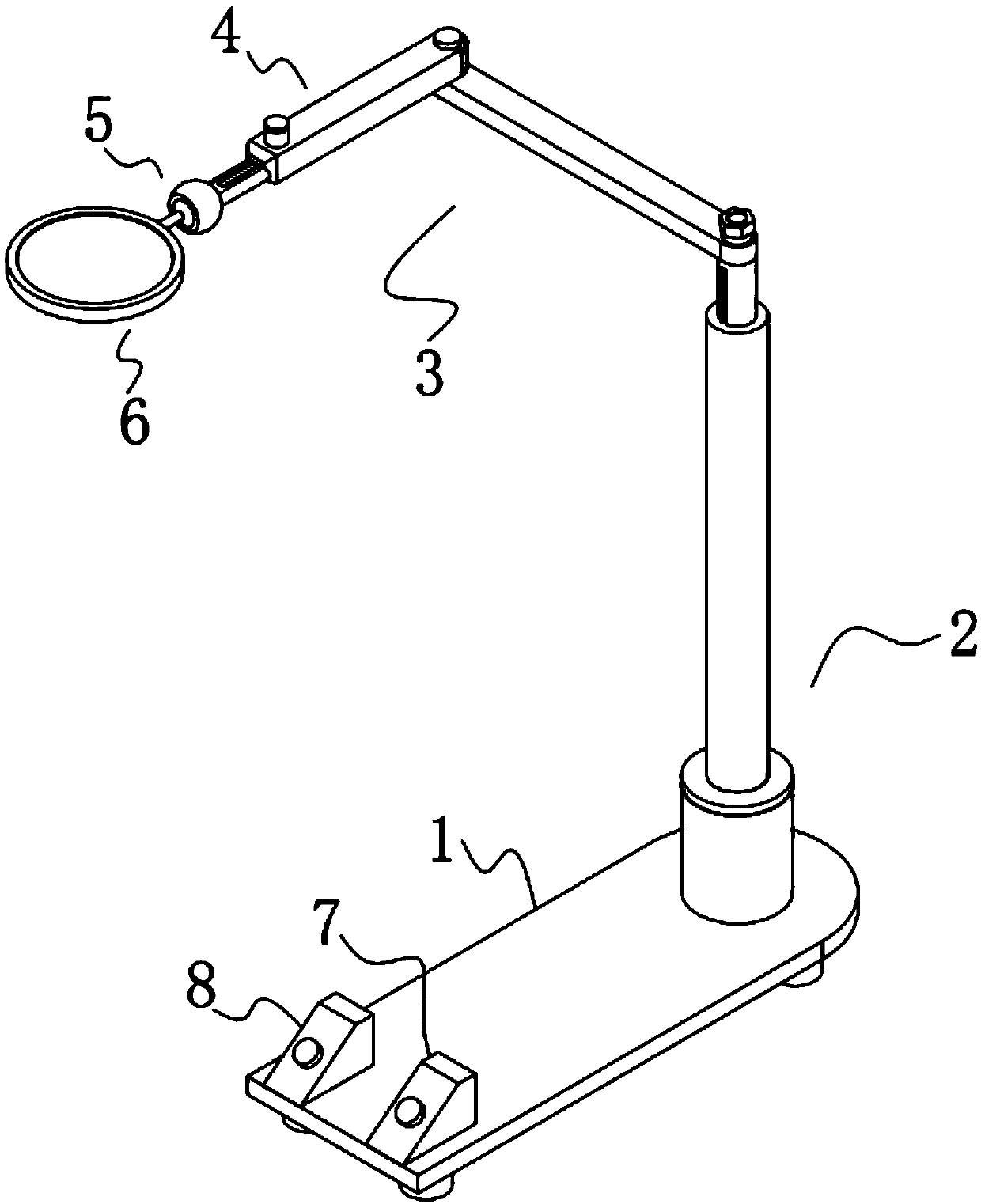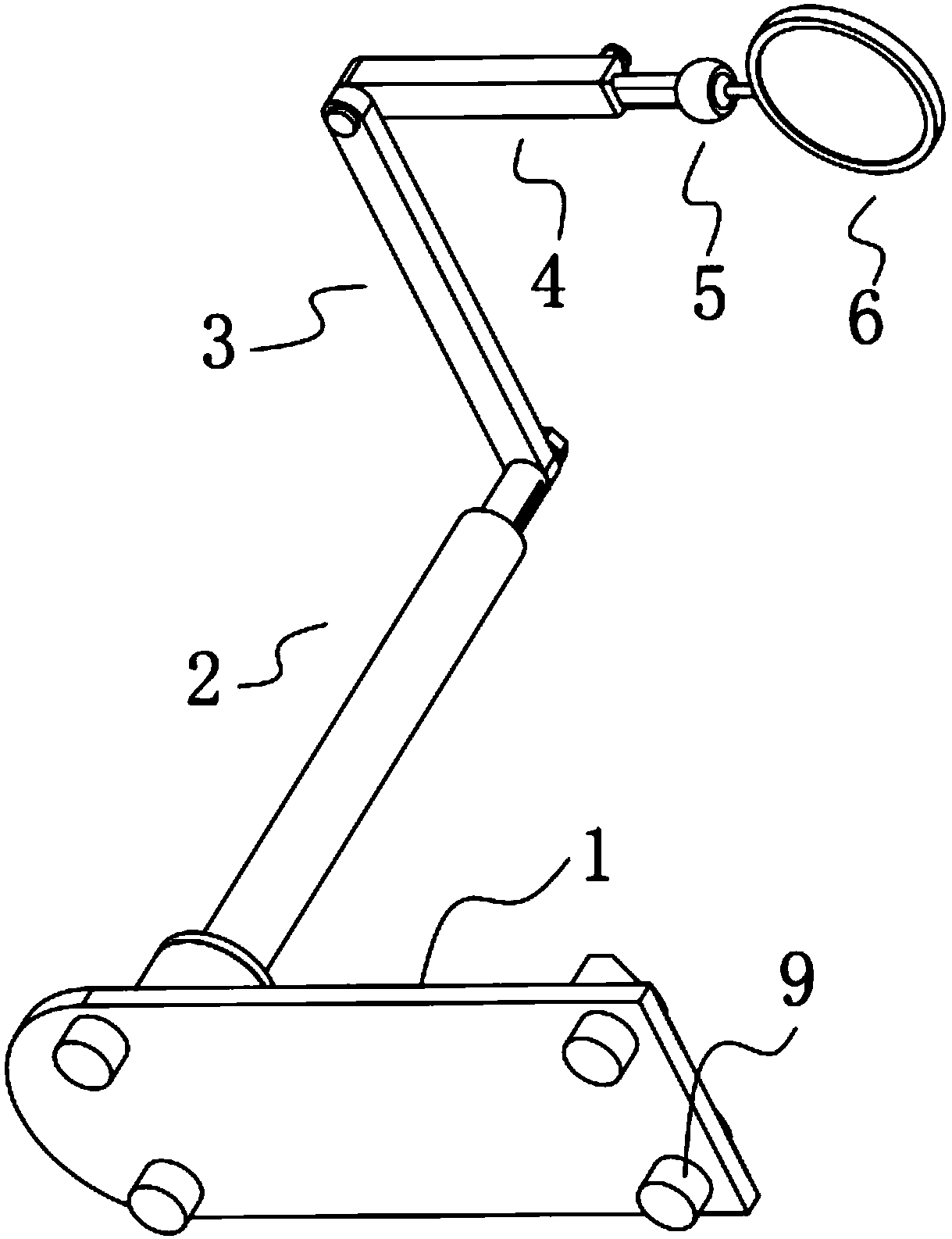Auxiliary device for cardiovascular operation
An auxiliary device and cardiovascular technology, applied in the field of medical devices, can solve the problems of increased surgical risk, weak operation flexibility, inconvenient use, etc., to achieve the effect of increasing the success rate of surgery, reducing the risk of surgery, and strong operational flexibility
- Summary
- Abstract
- Description
- Claims
- Application Information
AI Technical Summary
Problems solved by technology
Method used
Image
Examples
Embodiment 1
[0051] An assisting device for cardiovascular surgery, such as Figure 1-2 As shown, it includes a base 1, a lifting unit 2 is fixedly installed on one side of the upper part of the base 1, an adjusting unit 3 is installed on the upper end of the lifting unit 2, and the end of the adjusting unit 3 away from the lifting unit 2 is hinged Part 5 is equipped with a magnifying glass 6 .
[0052] By adopting the above-mentioned technical scheme, the magnifying glass 6 is used to assist the cardiovascular surgeon to clearly check the distribution of the patient's cardiovascular system and the location of cardiovascular lesions, so as to ensure the smooth progress of the operation. The lifting unit 2 is used to adjust the vertical position of the magnifying glass 6. Straight height, in order to cooperate with the use of different heights of the operating table, the adjustment unit 3 is used to adjust the angle of the magnifying glass 6 in the horizontal plane, which is convenient for ...
Embodiment 2
[0073] The difference from Example 1 is that the surface of the base 1 is also provided with a protective layer, and the protective layer is prepared by the following method:
[0074] Take the following raw materials and weigh them by weight: 20 parts of epoxy resin, 8 parts of titanium dioxide powder, 15 parts of acrylic emulsion, 14 parts of phenolic resin, 9 parts of quartz powder, 15 parts of polytetrafluoroethylene, 13 parts of nano silver powder, ten parts of alcohol ester 2 parts of two, 5 parts of triethanolamine, 2 parts of emulsified silicone oil and 30 parts of water;
[0075] S1. Add the weighed acrylic emulsion, alcohol ester dodeca, triethanolamine, emulsified silicone oil and water into the mixer and stir for 22min at a stirring speed of 600r / min to prepare a mixed solution;
[0076] S2. Add epoxy resin, titanium dioxide powder, nano-silver powder, phenolic resin, quartz powder and polytetrafluoroethylene into the pulverizer and pulverize until the particle diam...
Embodiment 3
[0082] The difference with embodiment 2 is the preparation of protective layer, and its specific preparation method is as follows:
[0083] Take the following raw materials and weigh them by weight: 25 parts of epoxy resin, 10 parts of titanium dioxide powder, 18 parts of acrylic emulsion, 16 parts of phenolic resin, 11 parts of quartz powder, 18 parts of polytetrafluoroethylene, 14 parts of nano silver powder, ten parts of alcohol ester 3 parts of two, 6 parts of triethanolamine, 3 parts of emulsified silicone oil and 40 parts of water;
[0084] S1. Add the weighed acrylic emulsion, alcohol ester dodeca, triethanolamine, emulsified silicone oil and water into the mixer and stir for 25min at a stirring speed of 700r / min to prepare a mixed solution;
[0085] S2. Add epoxy resin, titanium dioxide powder, nano-silver powder, phenolic resin, quartz powder and polytetrafluoroethylene into the pulverizer and pulverize until the particle diameter of the material is not greater than 3...
PUM
 Login to View More
Login to View More Abstract
Description
Claims
Application Information
 Login to View More
Login to View More - R&D Engineer
- R&D Manager
- IP Professional
- Industry Leading Data Capabilities
- Powerful AI technology
- Patent DNA Extraction
Browse by: Latest US Patents, China's latest patents, Technical Efficacy Thesaurus, Application Domain, Technology Topic, Popular Technical Reports.
© 2024 PatSnap. All rights reserved.Legal|Privacy policy|Modern Slavery Act Transparency Statement|Sitemap|About US| Contact US: help@patsnap.com










